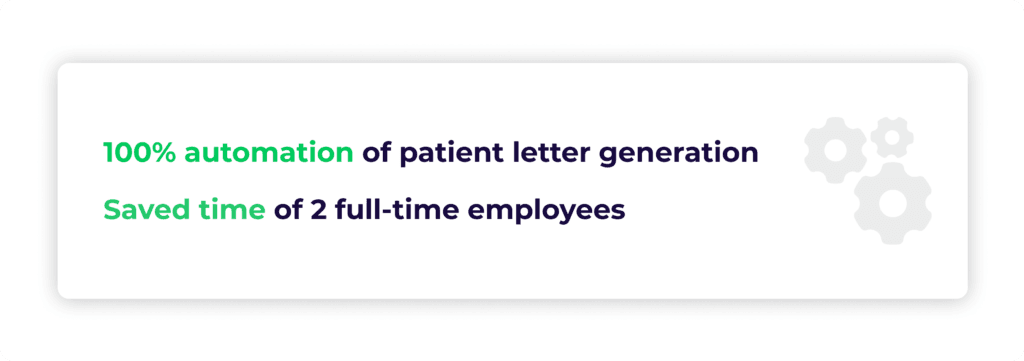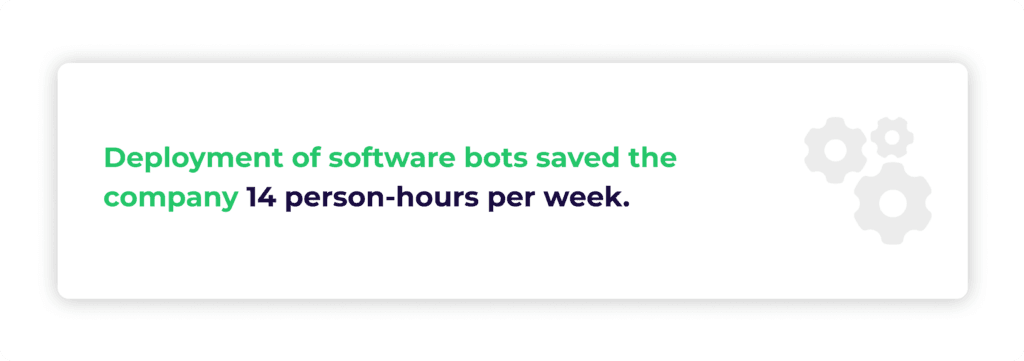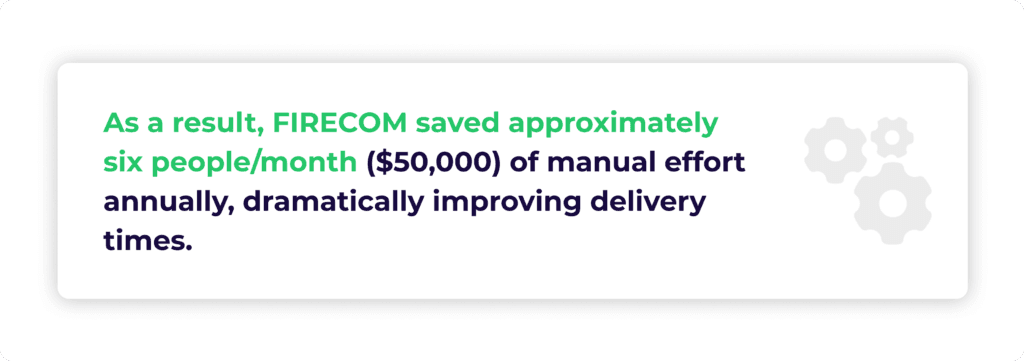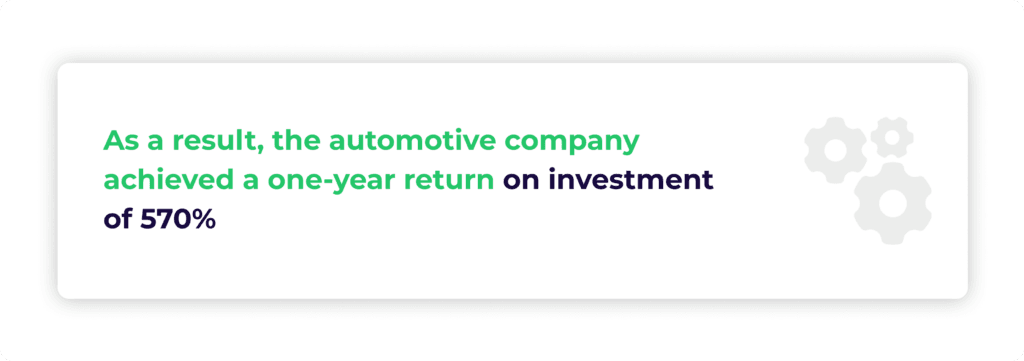Robotic Process Automation (RPA) offers a significant advantage to businesses as it operates around the clock without requiring human intervention, resulting in reduced error rates and the elimination of repetitive data-handling tasks that consume valuable time. Furthermore, RPA is a business process solution that positively impacts organizations' bottom line in any industry.
What kind of business processes does RPA help with?
Although RPA can be used for many business functions across various industries, there are scenarios where it should be used, and instances where it is not recommended. When looking internally at your business processes, your workflows should have the following characteristics to be good candidates for RPA.

Rule-based: A rule-based process performs a task or decides based on predefined rules or instructions. A task must be rule-based to be a good candidate for RPA; if the task is not, it will most likely not be a good candidate.
Repetitive: Repetitive tasks are performed regularly and require the same actions or steps to be completed. A repetitive task is another great candidate for RPA, if the task has any variance in actions performed, these actions must be rule-based to be taken over by RPA.
Time-consuming: Time-consuming tasks are great candidates for automation because RPA helps transition the task from an employee to a software bot, where that employee can be utilized in business areas requiring human decision-making. Most repetitive and rule-based tasks are time-consuming, making them highly recommended for RPA.
Requires one or more employees: A task may or may not require one or more employees to produce output. The more employees the task requires, the larger the potential savings to the business.
Error Prone: Tasks prone to human error can significantly raise business operating costs. Software bots are programmed to follow specific rules and procedures, reducing the likelihood of human error. This means that tasks are completed accurately and consistently every time, reducing the risk of errors.
Now that you understand what tasks can be automated with RPA software let’s dive into how RPA can help reduce costs.
1. Improved Efficiency and Employee Productivity
RPA automates repetitive and rule-based tasks, which saves employees and business owners time. Increased efficiency naturally leads to cost savings by reducing the time and resources required to complete tasks. Automating high-volume, repetitive tasks can improve employees' work-life balance, as large workloads and increased stress contribute to high employee turnover and decreased productivity.
As a result, RPA takes tasks off employees' plates so the employees focus on more valuable tasks that require strategic decision-making, problem-solving skills, management, and more. Using a software bot for tasks allows employees to focus on work they previously could not do because they did not have the time.
Actual Case Study for Improved Productivity through Automation
Patient Care Advocates in a hospital generated customized letters for each patient’s needs and appointment type. The employees created, printed, and mailed the letters to patients before appointments. Each letter required unique customizations based on the patient, taking PCAs up to 10 minutes to create and print each letter.
With high employee turnover, the hospital struggled to maintain the necessary number of trained PCAs to meet the demand.

The workflow was automated, and bots produced 100% of the hospital’s referral letters, saving two full-time employees’ time across the PCA team and keeping them more productive with fewer interruptions. The PCAs use the recovered time to set more appointments, getting patients in sooner and “closing the loop” with patients to confirm they did attend their appointment and to schedule any additional appointments.
2. Improved Accuracy
Another great benefit of automation software for rule-based tasks is error reduction and improved accuracy. High-volume data entry tasks, especially financial-related workflows, are prone to human error.
A well-programmed software bot follows the rules set by the process manager and will not deviate or make mistakes, which reduces overall costs from errors.
Actual Case Study for Improved Accuracy through Automation
An e-commerce company selling second-hand clothing on multiple online platforms concurrently needed help with its delisting products process. When an item sells, team members have to remove the item from all the other online platforms manually to avoid overselling the item.
The company’s employees spent two hours removing these listings daily. The cumbersome workflow resulted in errors and took about 14 hours per week.

Deployment of software bots saved the company 14 person-hours per week. As a result, the e-commerce company was able to focus on more valuable tasks to improve the customer experience.
Improved productivity translated to lower business costs and increased employee productivity and morale.
3. Reduced Labor Costs and IT Expenses
RPA can help reduce labor costs by automating tasks that would otherwise require human intervention. This can reduce the need for additional staff and allow existing staff to focus on more strategic tasks.
In addition, if a business uses many legacy systems within its operations, RPA helps bridge the gap between data entry and tasks involved with connecting outdated systems.
Some RPA platforms offer no-code or low-code software bots, enabling the business to leverage and deploy automation without hiring additional IT staff, which can be costly.
Actual ROI Calculation for Automated Ticket Creation/Management

4. Faster Turnaround Times
RPA reduces turnaround times by automating tasks that would otherwise require manual intervention. This reduces the time it takes to complete tasks and enables businesses to respond more quickly to customer needs and deadlines.
Actual Case Study for Automation Decreasing Turnaround Times
Employees at a fire and rescue company, FIRECOM, spent significant time processing invoices for billing and collections. Each group of accounts had a dedicated billing and collection staff. The staff manually extracted invoice data from a database, matching it against the respective customer service contract, entering billing, attaching the file to email, and dispersing it to each customer.
This process typically took each account group over 30 days to complete, so the collections process was usually behind schedule.
Invoice processing automation was deployed, improving turnaround times and cash flows.

5. Scalability
RPA also helps businesses scale their operations without incurring significant costs. Even if the volume of work increases, businesses automating more tasks naturally leads to cost savings and increased efficiency.
As a result, a business with growing operations can deploy RPA instead of hiring additional staff to handle the increased workloads, and current employees can enjoy an improved work life balance.
Actual Case Study for Increased Scalability with Automation
An automotive company was using an alternative RPA platform to execute data scraping from multiple web sources. The customer team applied business logic to that data and stored it in their data lake.
As the automotive company began to scale its automation, it realized it needed more employees to keep up with the increasing volume of data scraping.
Accounting for the costs of licensing, re-platforming, testing, and redeploying bots with ElectroNeek, the client achieved a one-year ROI of 570%, which resulted in a two-month payback.

In addition to the increased ROI, the automation increased efficiency, reduced errors, and resulted in higher data accuracy to support strategic business decisions. The company could quickly grow its operations without hiring additional staff to handle the incoming volume of tasks.
Leverage RPA to Scale Your Business
RPA helps businesses save money by reducing the need for manual labor, increasing efficiency, and minimizing errors that can lead to costly mistakes. Automating repetitive and time-consuming tasks empowers employees to focus on more valuable and strategic work, ultimately leading to increased productivity and profitability.
By leveraging RPA, businesses scale more quickly and easily, as they automate processes without hiring additional staff. RPA is a powerful tool for businesses looking to improve their bottom line and stay competitive in today’s fast-paced market.
